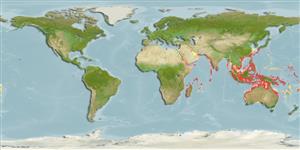Environment: milieu / climate zone / depth range / distribution range
Ökologie
seewasser; brackwasser riff-verbunden; tiefenbereich 0 - 20 m (Ref. 127989). Subtropical; 32°N - 33°S, 28°E - 178°W
Indo-West Pacific: Red Sea and East Africa to southern Japan, New Guinea and Arafura Sea (Ref. 9819). Reported from Vanuatu (Ref. 13300). Migrated to the Mediterranean from the Red Sea via the Suez Canal (Ref. 5385).
Size / Gewicht / Alter
Maturity: Lm ? range ? - ? cm
Max length : 30.0 cm TL Männchen/unbestimmt; (Ref. 30573)
Rückenflossenstacheln (insgesamt): 12 - 13; Rückenflossenweichstrahlen (insgesamt): 8-11; Afterflossenstacheln 3; Afterflossenweichstrahlen: 9 - 11. Generally silver in color, with 4-6 dark horizontal lines; a black blotch behind head and below dorsal origin and another in front of dorsal fin may be present; caudal fin pale or slightly dusky (Ref. 4327).
Are coastal species often found in brackish waters; common in estuaries. They croak when taken from the water. Usually forming schools. Juveniles in seagrass beds and in mangrove bays (Ref. 48635). Feed on small fishes and invertebrates. Eggs are guarded and fanned by the male parent (Ref. 205). Maximum depth reported taken from Ref. 127989.
Life cycle and mating behavior
Geschlechtsreife | Fortpflanzung | Ablaichen | Eier | Fecundity | Larven
Eggs are guarded and fanned by the male parent (Ref. 205).
Paxton, J.R., D.F. Hoese, G.R. Allen and J.E. Hanley, 1989. Pisces. Petromyzontidae to Carangidae. Zoological Catalogue of Australia, Vol. 7. Australian Government Publishing Service, Canberra, 665 p. (Ref. 7300)
IUCN Rote Liste Status (Ref. 130435)
Bedrohung für Menschen
Harmless
Nutzung durch Menschen
Fischereien: weniger kommerziell
Mehr Information
ReferenzenAquakulturAquakultur ProfilZuchtlinienGenetikElectrophoresesVererbbarkeitKrankheitenVerarbeitungNutrientsMass conversion
PartnerBilderStamps, Coins Misc.LauteCiguateraGeschwindigkeitSchwimmstilKiemenoberflächeOtolithsGehirngrößeSehfähigkeit
Tools
Zusatzinformationen
Download XML
Internet Quellen
Estimates based on models
Preferred temperature (Ref.
123201): 24.4 - 29, mean 28 °C (based on 1262 cells).
Phylogenetic diversity index (Ref.
82804): PD
50 = 0.6250 [Uniqueness, from 0.5 = low to 2.0 = high].
Bayesian length-weight: a=0.01047 (0.00667 - 0.01644), b=3.01 (2.88 - 3.14), in cm total length, based on LWR estimates for this species & (Sub)family-body (Ref.
93245).
Trophic level (Ref.
69278): 3.6 ±0.4 se; based on diet studies.
Widerstandsfähigkeit (Ref.
120179): mittel, Verdopplung der Population dauert 1,4 - 4,4 Jahre. (Preliminary K or Fecundity.).
Fishing Vulnerability (Ref.
59153): Low vulnerability (20 of 100).
Climate Vulnerability (Ref.
125649): Moderate to high vulnerability (50 of 100).
Nutrients (Ref.
124155): Calcium = 34.7 [16.7, 81.9] mg/100g; Iron = 0.604 [0.350, 0.984] mg/100g; Protein = 20.1 [19.1, 21.1] %; Omega3 = 0.256 [0.154, 0.426] g/100g; Selenium = 14.2 [6.9, 26.8] μg/100g; VitaminA = 50.8 [15.9, 162.8] μg/100g; Zinc = 0.954 [0.631, 1.405] mg/100g (wet weight);
